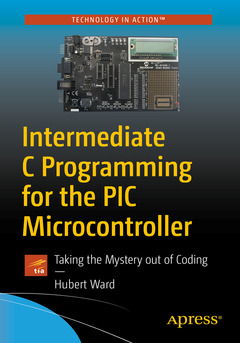Intermediate C Programming for the PIC Microcontroller, 1st ed. Simplifying Embedded Programming
Auteur : Ward Hubert Henry

Delve into the exciting world of embedded programming with PIC microcontrollers in C. The key to learning how to program is to understand how the code works ? and that is what you?ll learn here.
Following C Programming for the PIC Microcontroller, this book continues exploring the coding required to control the PIC microcontroller and can be used as a standalone single reference, or paired with the previous title to enhance your programming skills. You'll see how to control the position of a servo motor and use the compare aspect of the CCP module to create a square wave with varying frequency. You'll also work with the capture aspect of the CCP to determine the frequency of a signal inputted to the PIC and use external and internal interrupts.
- Create a small musical keyboard with the PIC
- Manage a stepper motor with the PIC
- Use the main features of the MPLABX IDE
- Interface the PIC to the real world
- Design and create useful programs based around the PIC18F4525
Hubert Ward has nearly 25 years of experience as a college lecturer delivering the BTEC, and now Pearson's, Higher National Certificate and Higher Diploma in Electrical & Electronic Engineering. Hubert has a 2.1 Honours Bachelor's Degree in Electrical & Electronic Engineering. Hubert has also worked as a consultant in embedded programming. His work has established his expertise in the assembler and C programming languages, within the MPLABX IDE from Microchip, as well as designing electronic circuits, and PCBs, using ECAD software. Hubert was also the UK technical expert in Mechatronics for three years, training the UK team and taking them to enter in the Skills Olympics in Seoul 2001, resulting in one of the best outcomes to date for the UK in Mechatronics.
Gain a complete understanding of how your code works with PIC microcontrollers
Work through practical projects and see your programs work by simulation with a ECAD package
Learn to fully create a PWM signal to set the speed of a DC motor, and how to capture and compare aspects of the CCP module
Date de parution : 09-2020
Ouvrage de 350 p.
15.5x23.5 cm
